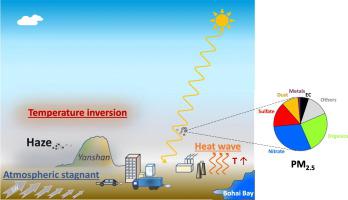Science of the Total Environment ( IF 8.2 ) Pub Date : 2021-05-17 , DOI: 10.1016/j.scitotenv.2021.147814 Min Shao , Qili Dai , Zhuojun Yu , Yufen Zhang , Mingjie Xie , Yinchang Feng

|
Air pollution is the result of enormous emissions and unfavorable meteorological conditions. The role of meteorology, particularly extremely unfavorable meteorological events (EUMEs), in processing atmospheric PM2.5 pollution has not been fully addressed. This work examined the variations of PM2.5 mass and its chemical components associated with various meteorological parameters and three EUMEs based on meteorological observations and analysis combined with one-year long in situ measurement in 2018 in the suburban area of Tianjin, China. Analysis shows that the polluted days in 2018 were mostly related to the increase in sulfate, nitrate, and ammonium (SNA). Temperature between −2 to 13 °C is more favorable for the formation of SNA, while high temperature exceeding 28 °C is favorable for the formation of organic carbon and sulfate. Most of the ions and carbon components showed significant increase in concentrations when relative humidity exceeded 80%. The maximum decreasing rate of PM2.5 concentrations due to increase in wind speed and planetary boundary height could be 15.35 μg m−3 (m s−1)−1, and 34.37 μg m−3 (100 m)−1, respectively. EUMEs showed significant impacts on PM2.5 components, in which PM2.5 concentrations showed the most significant increase under temperature inversion (TI) events, and surface-based TI (SBTI) events usually have much stronger impacts on PM2.5 concentrations than elevated TI (ELTI). Nitrate was found to be the most sensitive component to EUMEs, especially under multiple EUMEs. The synthetic effects of multiple EUMEs could result in an increase of nitrate by 35.53 μg m−3 (523.3%). In addition, OC and sulfate are more sensitive to heat wave events. Our analysis provides improved understanding of the formation of PM2.5 pollution with respect to meteorology, particularly EUMEs. Based on such information, more attention may be needed on the collaborative prediction of EUMEs and air pollution episodes.











































 京公网安备 11010802027423号
京公网安备 11010802027423号